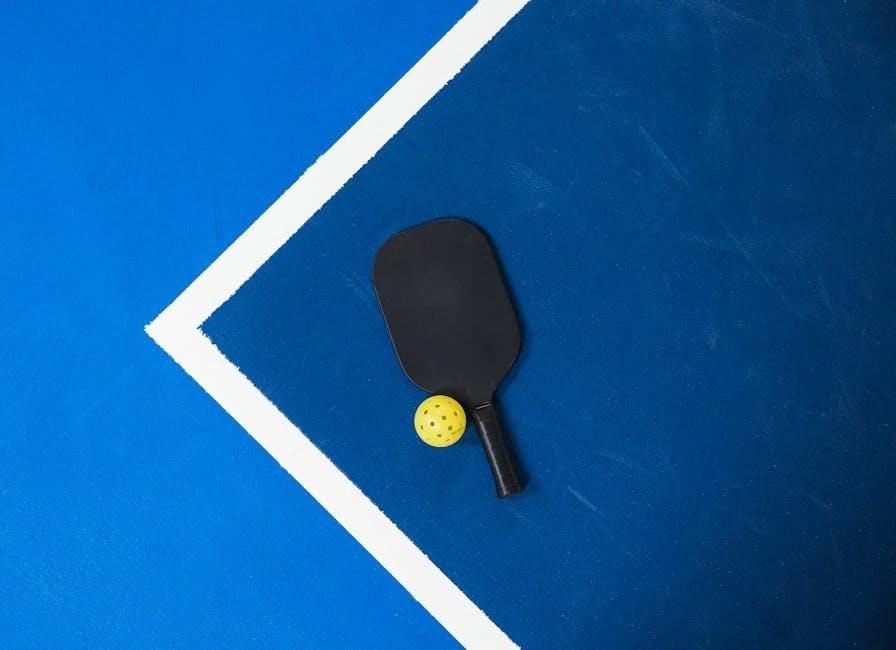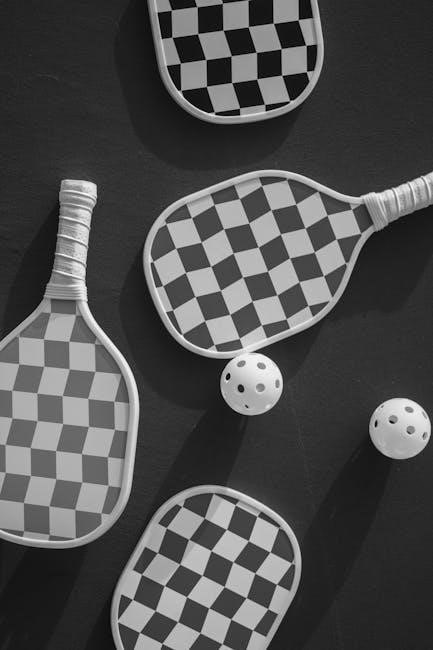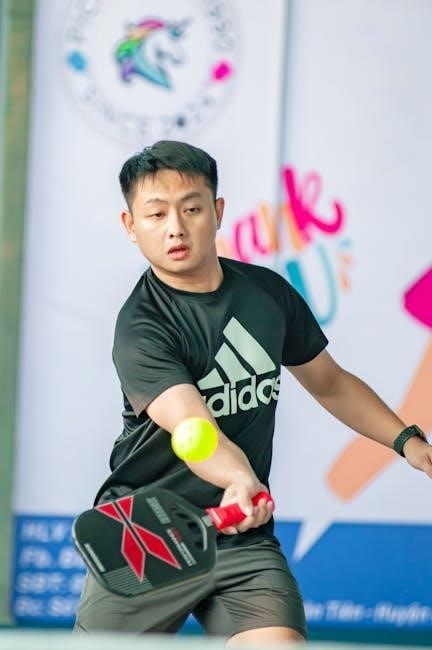
Welcome to our Pickleball Paddle Buying Guide! This guide helps players make informed decisions by covering essential factors, ensuring you find the perfect paddle for your needs.
1.1 Importance of Choosing the Right Pickleball Paddle
Choosing the right pickleball paddle is crucial for optimizing performance, comfort, and overall enjoyment of the game. A well-suited paddle enhances control, power, and precision, allowing players to execute shots effectively. It also reduces the risk of injury by providing proper weight distribution and ergonomics. With so many options available, selecting a paddle that aligns with your skill level, playing style, and personal preferences is essential. This guide will help you navigate the key factors to consider, ensuring your paddle becomes an extension of your game.
1.2 Overview of Key Factors to Consider
When selecting a pickleball paddle, several key factors come into play to ensure you find the best fit for your game. Paddle size, shape, and weight significantly impact performance, with standard dimensions ranging from 7.75 to 8 inches in width. Core materials, such as polypropylene or Nomex, affect durability and play feel, while surface texture influences spin and control. Handle length and grip size also matter for comfort and maneuverability. Additionally, budget, warranty, and advanced features like edge guards or vibration dampening should be considered. Understanding these elements helps narrow down options to suit your style and preferences.

Understanding Paddle Size and Shape
Pickleball paddles typically range from 7.75 to 8 inches in width, with shape influencing reach and maneuverability. Both factors are crucial for optimal performance and control.
2.1 Standard Paddle Dimensions
Pickleball paddles typically measure 7.75 to 8 inches in width and 15 to 15.75 inches in length, with a combined length and width not exceeding 24 inches. The shape varies slightly, with most paddles featuring a rectangular or slightly rounded design. These dimensions are standardized to ensure fair play and consistent performance. A longer handle allows for two-handed shots, while a shorter one enhances maneuverability. Understanding these measurements helps players choose a paddle that suits their style, whether they prioritize power, control, or versatility. Proper dimensions are essential for optimal gameplay and compliance with official regulations.
2.2 Paddle Shape and Its Impact on Performance
Pickleball paddles come in various shapes, including rectangular, rounded, and teardrop designs. The shape significantly influences performance, with rectangular paddles offering a larger hitting surface for power, while rounded edges improve control and maneuverability. Teardrop-shaped paddles balance both attributes, catering to versatile players. The shape also affects swing speed and accuracy, making it crucial for players to align their choice with their playing style. Whether focusing on power, precision, or all-around play, the paddle’s shape plays a vital role in enhancing overall performance and player satisfaction on the court.
Paddle Weight and Distribution
Pickleball paddles vary in weight, impacting performance. Lightweight paddles enhance swing speed and control, while heavier ones deliver more power. Proper weight distribution ensures balance and maneuverability.
3.1 Lightweight vs. Heavyweight Paddles
Pickleball paddles come in various weights, typically ranging from 7.5 to 14 ounces. Lightweight paddles (7.5–8;5 oz) offer improved swing speed and control, ideal for quick reflexes and precise shots. They are recommended for beginners or players prioritizing agility. Heavyweight paddles (9–14 oz) provide more power, making them suitable for advanced players seeking stronger hits. However, heavier paddles can fatigue arms over time. Choosing the right weight depends on your playstyle, strength, and performance goals. Balancing power and maneuverability is key to optimizing your game performance and comfort on the court.
3.2 Weight Distribution: Balanced, Head-Heavy, and Head-Light Paddles
Pickleball paddles vary in weight distribution, impacting performance. Balanced paddles offer uniform weight, ideal for all-around play. Head-heavy paddles provide extra power for strong shots. Head-light paddles enhance maneuverability and quick reflexes. Each suits different styles: balanced for consistency, head-heavy for power hitters, and head-light for agility-focused players. Consider your playstyle and physical comfort to choose the right distribution, ensuring optimal performance and comfort during gameplay.

Core Materials and Their Significance
Core materials like polypropylene, Nomex, and composite significantly impact a paddle’s performance. They influence durability, sound, and pop, ensuring optimal playability and feel for all skill levels.
4.1 Polypropylene (Poly) Core
A polypropylene (poly) core is a popular choice for pickleball paddles, known for its durability and excellent sound. It offers a great balance between power and control, making it suitable for various playing styles. Poly cores are lightweight yet sturdy, providing consistent performance over time. They are also resistant to warping and can withstand intense gameplay. Many players prefer poly cores for their affordability and reliability. However, they may lack the premium feel of other materials like Nomex. Overall, poly cores are a versatile option for players seeking a durable and cost-effective paddle.
4.2 Nomex Core
A Nomex core is a high-performance option known for its exceptional power and responsiveness. Nomex, a unique honeycomb structure, provides a solid feel and enhanced pop, making it ideal for advanced players. It offers superior durability and can handle high-impact shots without losing shape. Nomex cores are slightly heavier than poly cores, which some players find beneficial for added stability. However, they are more expensive and may produce a louder sound upon impact. For those seeking premium performance and willing to invest, Nomex cores deliver outstanding results and are favored by competitive players.
4.3 Composite Core
A composite core combines materials like polypropylene and fiberglass, offering a balance between power and control. It provides consistent performance across various playing styles. Composite cores are durable and resistant to wear, making them a great option for players seeking long-term reliability. They also tend to absorb vibrations better, reducing shock during impact. Suitable for both beginners and experienced players, composite cores strike a balance between affordability and performance. This versatility makes them a popular choice for those looking for a paddle that excels in multiple aspects of the game without breaking the bank.

Surface Materials and Texture
Explore surface materials like graphite and fiberglass, each offering unique performance benefits. Texture plays a crucial role in spin and control, enhancing gameplay for players of all levels.
5.1 Graphite vs. Fiberglass Surfaces
When choosing a pickleball paddle, the surface material significantly impacts performance. Graphite surfaces are lightweight, offering a solid feel and exceptional power for precise shots. They are ideal for advanced players seeking control and durability. On the other hand, fiberglass surfaces provide a softer touch, enhancing spin and forgiveness, making them perfect for beginners or those prioritizing touch over power. Both materials have their advantages, so selecting the right one depends on your playing style and skill level. Understanding these differences helps you make an informed decision to elevate your game.
5.2 Surface Texture for Spin and Control
Surface texture plays a crucial role in determining spin and control for pickleball paddles. A smooth surface minimizes friction, allowing for faster ball movement and reduced spin, ideal for players who prioritize power and speed. Conversely, a textured surface creates more friction, enabling better grip on the ball for sharper spins and precise shots; The texture’s depth and pattern can significantly impact performance, with deeper textures generally offering more spin potential. Players should consider their playing style and whether they value control, spin, or raw power when selecting a paddle with the appropriate surface texture.
Handle Length and Grip Size
Handle length and grip size are vital for comfort and control. Standard lengths suit most players, while extended handles aid two-handed shots. Proper grip size prevents slipping and enhances accuracy.
6.1 Standard vs. Extended Handle Lengths
Standard handle lengths typically range from 4 to 5 inches, offering a balanced feel for most players. Extended handles, often 5 to 6 inches, provide extra leverage for two-handed shots and improved control. Standard lengths are ideal for single-handed play, while extended handles cater to players who prefer added power or dual-handed techniques. Choosing the right handle length depends on personal preference and playing style, ensuring comfort and effectiveness on the court. Proper handle length enhances overall performance and reduces fatigue during extended play.
6.2 Importance of Proper Grip Size
Grip size is crucial for comfort and control in pickleball. A grip that’s too small can cause slipping, while one that’s too large may hinder wrist movement. Proper grip size ensures a firm hold, reducing fatigue and improving accuracy. Most paddles offer grip sizes between 4 and 5 inches in circumference. Players with smaller hands may prefer a smaller grip, while those with larger hands or who wear gloves might opt for a larger size. Testing different grips can help determine the best fit for individual comfort and performance. A well-fitting grip enhances overall playability and reduces the risk of injury.

Price Range and Budget Considerations
Pickleball paddles vary in price, with entry-level options starting around $40-$70, mid-range paddles costing $70-$120, and high-end models priced $120-$250. Budget accordingly based on skill level and desired features.
7.1 Entry-Level Paddles
Entry-level pickleball paddles are an excellent choice for beginners, typically priced between $40 to $70. These paddles are made from durable materials like polypropylene cores and fiberglass surfaces, offering a balance of affordability and performance. They are lightweight, making them easy to maneuver for new players. While they may lack advanced features, they provide great value for those learning the game or playing casually. Entry-level paddles are a smart investment for anyone looking to explore pickleball without breaking the bank.
7.2 Mid-Range Paddles
Mid-range pickleball paddles are ideal for intermediate players seeking improved performance without the premium price. Priced between $70 and $120, these paddles often feature high-quality materials like composite cores (combining polypropylene and Nomex) and durable surfaces made from graphite or high-end fiberglass. They offer better control, power, and spin compared to entry-level options. Mid-range paddles are suitable for players who have honed their skills and want a balance of performance and value. Additional features like edge guards and vibration dampening may also be included, enhancing playability and comfort for advancing players.
7.3 High-End Paddles
High-end pickleball paddles are designed for advanced players seeking top-tier performance, typically priced between $120 and $300. These paddles feature premium materials like advanced composite cores, high-end graphite surfaces, and cutting-edge technologies such as vibration dampening systems. They offer exceptional power, control, and spin, catering to players who demand precision and durability. High-end models often include edge guards, extended handles, and ergonomic grips for enhanced playability. With superior craftsmanship and innovative designs, these paddles are ideal for competitive play and serious enthusiasts who want the best equipment to elevate their game.

Warranty and Durability
Warranty and durability are crucial for long-term satisfaction. A good manufacturer’s warranty ensures coverage for defects, while durable materials and construction extend the paddle’s lifespan for consistent performance.
8.1 Understanding Manufacturer Warranties
Manufacturer warranties play a vital role in protecting your investment. Most paddles come with a warranty covering defects in materials and workmanship for a specific period, typically ranging from a few months to a year or more. High-quality paddles often have longer warranties, reflecting their durability. When evaluating a warranty, consider what it covers, such as cracks, dents, or structural issues. The warranty period and terms vary by brand, so it’s essential to review them before purchasing. A comprehensive warranty ensures peace of mind and protection against manufacturing flaws.
8.2 Signs of a Durable Paddle
A durable pickleball paddle is built to withstand regular play and last for years. Look for paddles with high-quality core materials, such as polypropylene or composite cores, which resist warping and cracking. A sturdy surface material, like graphite or fiberglass, adds durability and minimizes dents. Edge guards and reinforced edges protect against impact damage. Weight distribution should be balanced to avoid excessive strain. Additionally, paddles from reputable brands with positive reviews and warranties are often more durable. Proper care, such as avoiding extreme temperatures, also extends a paddle’s lifespan, ensuring consistent performance over time.

Additional Features to Consider
Additional features to consider include edge guards for protection, vibration dampening for reduced shock, and aesthetic designs for personalized style, enhancing both performance and player satisfaction.
9.1 Edge Guards
Edge guards are protective features that shield the edges of your pickleball paddle from wear and tear. They prevent chipping, cracking, and damage caused by accidental hits or drops. While they add minimal weight, edge guards extend the paddle’s lifespan, ensuring durability and maintaining performance over time. Some players prefer paddles without edge guards for a lighter feel, but for those seeking longevity and protection, edge guards are a practical addition to consider when selecting a pickleball paddle.
9.2 Vibration Dampening Technology
Vibration dampening technology reduces the shock and sting felt when hitting the ball, enhancing comfort and control. This feature is especially beneficial for players with joint pain or those who prefer a smoother playing experience. Advanced materials and designs, such as cushioned cores or specialized polymers, absorb impact vibrations. While it may slightly increase weight, the benefits of reduced fatigue and improved feel make it a worthwhile consideration for many players. This technology is particularly popular among those prioritizing comfort and performance in their pickleball paddle.
9.3 Aesthetic Design and Color Options
Aesthetic design and color options allow players to personalize their pickleball paddle, making it a reflection of their style. Many paddles feature vibrant colors, unique graphics, or artistic designs, enabling players to stand out on the court. While functionality is paramount, the visual appeal of a paddle can boost confidence and enjoyment. Some paddles offer customizable options, while others come in sleek, professional designs. Whether you prefer bold and eye-catching or subtle and understated, there’s a paddle to match your preferences. Aesthetic choices ensure your equipment aligns with your personality and enhances your overall pickleball experience.